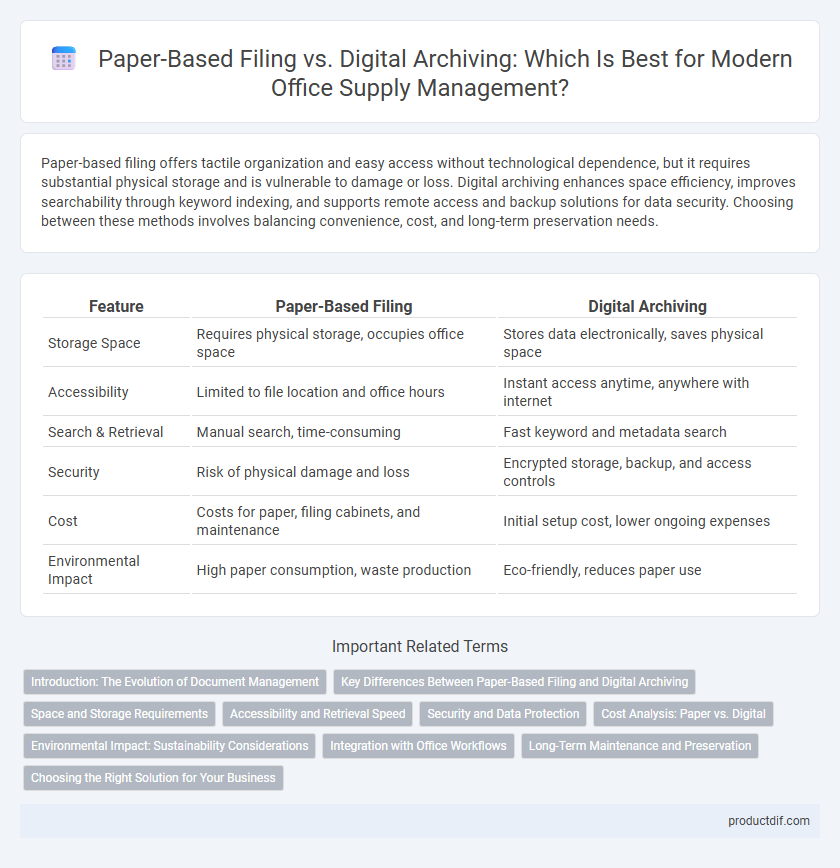Paper-based filing offers tactile organization and easy access without technological dependence, but it requires substantial physical storage and is vulnerable to damage or loss. Digital archiving enhances space efficiency, improves searchability through keyword indexing, and supports remote access and backup solutions for data security. Choosing between these methods involves balancing convenience, cost, and long-term preservation needs.
Table of Comparison
| Feature | Paper-Based Filing | Digital Archiving |
|---|---|---|
| Storage Space | Requires physical storage, occupies office space | Stores data electronically, saves physical space |
| Accessibility | Limited to file location and office hours | Instant access anytime, anywhere with internet |
| Search & Retrieval | Manual search, time-consuming | Fast keyword and metadata search |
| Security | Risk of physical damage and loss | Encrypted storage, backup, and access controls |
| Cost | Costs for paper, filing cabinets, and maintenance | Initial setup cost, lower ongoing expenses |
| Environmental Impact | High paper consumption, waste production | Eco-friendly, reduces paper use |
Introduction: The Evolution of Document Management
Paper-based filing has been the traditional method of document management, relying on physical folders and cabinets to organize important records. Digital archiving has transformed this landscape by enabling electronic storage, easy retrieval, and enhanced security of documents through cloud services and indexing software. The shift from paper to digital systems reduces physical space requirements and accelerates information access for businesses of all sizes.
Key Differences Between Paper-Based Filing and Digital Archiving
Paper-based filing relies heavily on physical storage space and manual organization, often leading to slower retrieval times and higher risks of document loss or damage. Digital archiving uses electronic systems that enable quick searchability, secure backups, and easy sharing of files, significantly improving efficiency and accessibility. While paper filing requires ongoing physical maintenance, digital archiving demands cybersecurity measures and regular software updates to protect data integrity.
Space and Storage Requirements
Paper-based filing demands substantial physical space for cabinets, folders, and shelving, often leading to cluttered offices and increased real estate costs. Digital archiving drastically reduces physical storage needs by consolidating vast amounts of documents into secure servers or cloud platforms, optimizing office layout and enabling easier document retrieval. Efficient digital storage systems also support scalable expansion without incremental space investment, enhancing long-term organizational efficiency.
Accessibility and Retrieval Speed
Paper-based filing requires physical access to storage locations, which can slow down document retrieval and limit accessibility outside the office. Digital archiving enables instant access to files through cloud-based systems, significantly improving retrieval speed and allowing remote accessibility. Advanced search algorithms and indexing in digital systems enhance accuracy and efficiency compared to manual paper searches.
Security and Data Protection
Paper-based filing offers tangible security benefits through controlled physical access and reduced exposure to cyber threats but risks damage from environmental factors and unauthorized handling. Digital archiving enhances data protection with encryption, backup solutions, and access controls, ensuring swift recovery and compliance with data privacy regulations. However, it requires robust cybersecurity measures to safeguard against hacking, data breaches, and system failures.
Cost Analysis: Paper vs. Digital
Paper-based filing incurs ongoing expenses such as purchasing paper, folders, storage cabinets, and physical space maintenance, which cumulatively increase operational costs over time. Digital archiving requires initial investment in hardware, software, and cybersecurity measures, but significantly reduces long-term expenditures by minimizing physical storage needs and enhancing retrieval efficiency. Studies indicate digital systems can cut filing costs by up to 70%, offering scalable solutions that optimize both budget and resource allocation in office management.
Environmental Impact: Sustainability Considerations
Paper-based filing consumes significant natural resources and contributes to deforestation, leading to higher carbon footprints compared to digital archiving. Digital archiving reduces paper waste and energy consumption over time, promoting eco-friendly office practices. Efficient data management systems in digital archiving further minimize environmental impact by decreasing the need for physical storage space.
Integration with Office Workflows
Paper-based filing often requires physical handling and manual sorting, which can disrupt office workflows and slow down document retrieval. Digital archiving integrates seamlessly with office software and cloud platforms, enabling quick access, searchability, and collaboration. Automated indexing and metadata tagging in digital systems streamline workflow integration, improving overall office efficiency.
Long-Term Maintenance and Preservation
Paper-based filing demands physical storage space and is vulnerable to deterioration, fading, and potential loss from environmental factors over time. Digital archiving offers enhanced long-term preservation through cloud storage, regular backups, and encryption, ensuring data integrity and easy retrieval. Compliance with regulatory standards such as HIPAA and GDPR is more efficiently managed with digital records, reducing risks associated with paper document degradation.
Choosing the Right Solution for Your Business
Paper-based filing offers tactile organization and immediate accessibility, ideal for businesses with minimal digital infrastructure and legal requirements mandating physical copies. Digital archiving enhances space efficiency, searchability, and disaster recovery capabilities, making it suitable for companies prioritizing scalability and remote access. Evaluating factors such as budget, regulatory compliance, workflow complexity, and data security helps determine the optimal solution for your business needs.
Paper-based filing vs Digital archiving Infographic

 productdif.com
productdif.com